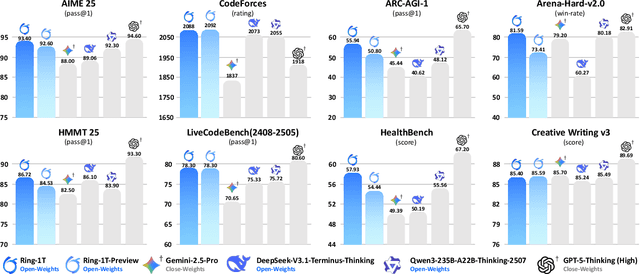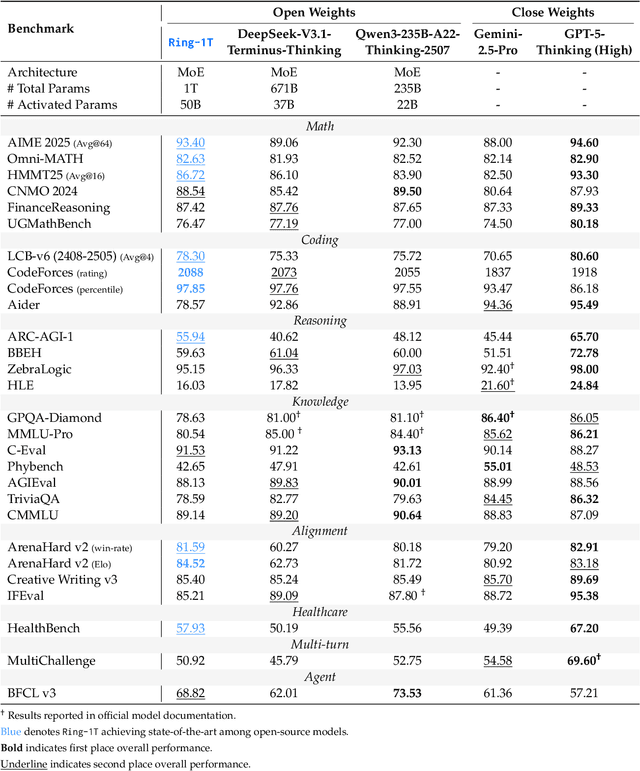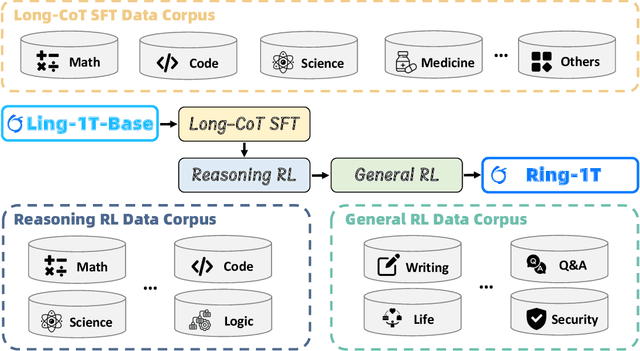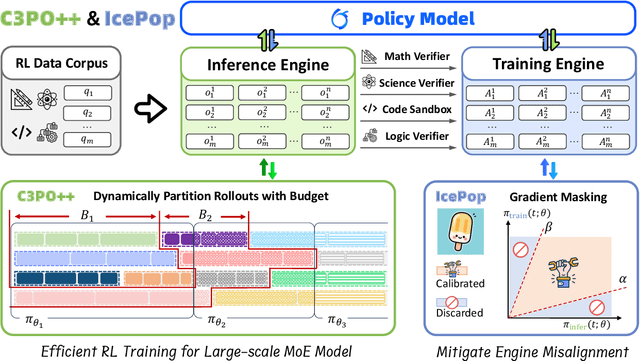Meng Li
RoboMIND 2.0: A Multimodal, Bimanual Mobile Manipulation Dataset for Generalizable Embodied Intelligence
Dec 31, 2025Abstract:While data-driven imitation learning has revolutionized robotic manipulation, current approaches remain constrained by the scarcity of large-scale, diverse real-world demonstrations. Consequently, the ability of existing models to generalize across long-horizon bimanual tasks and mobile manipulation in unstructured environments remains limited. To bridge this gap, we present RoboMIND 2.0, a comprehensive real-world dataset comprising over 310K dual-arm manipulation trajectories collected across six distinct robot embodiments and 739 complex tasks. Crucially, to support research in contact-rich and spatially extended tasks, the dataset incorporates 12K tactile-enhanced episodes and 20K mobile manipulation trajectories. Complementing this physical data, we construct high-fidelity digital twins of our real-world environments, releasing an additional 20K-trajectory simulated dataset to facilitate robust sim-to-real transfer. To fully exploit the potential of RoboMIND 2.0, we propose MIND-2 system, a hierarchical dual-system frame-work optimized via offline reinforcement learning. MIND-2 integrates a high-level semantic planner (MIND-2-VLM) to decompose abstract natural language instructions into grounded subgoals, coupled with a low-level Vision-Language-Action executor (MIND-2-VLA), which generates precise, proprioception-aware motor actions.
ATLAS: A High-Difficulty, Multidisciplinary Benchmark for Frontier Scientific Reasoning
Nov 18, 2025Abstract:The rapid advancement of Large Language Models (LLMs) has led to performance saturation on many established benchmarks, questioning their ability to distinguish frontier models. Concurrently, existing high-difficulty benchmarks often suffer from narrow disciplinary focus, oversimplified answer formats, and vulnerability to data contamination, creating a fidelity gap with real-world scientific inquiry. To address these challenges, we introduce ATLAS (AGI-Oriented Testbed for Logical Application in Science), a large-scale, high-difficulty, and cross-disciplinary evaluation suite composed of approximately 800 original problems. Developed by domain experts (PhD-level and above), ATLAS spans seven core scientific fields: mathematics, physics, chemistry, biology, computer science, earth science, and materials science. Its key features include: (1) High Originality and Contamination Resistance, with all questions newly created or substantially adapted to prevent test data leakage; (2) Cross-Disciplinary Focus, designed to assess models' ability to integrate knowledge and reason across scientific domains; (3) High-Fidelity Answers, prioritizing complex, open-ended answers involving multi-step reasoning and LaTeX-formatted expressions over simple multiple-choice questions; and (4) Rigorous Quality Control, employing a multi-stage process of expert peer review and adversarial testing to ensure question difficulty, scientific value, and correctness. We also propose a robust evaluation paradigm using a panel of LLM judges for automated, nuanced assessment of complex answers. Preliminary results on leading models demonstrate ATLAS's effectiveness in differentiating their advanced scientific reasoning capabilities. We plan to develop ATLAS into a long-term, open, community-driven platform to provide a reliable "ruler" for progress toward Artificial General Intelligence.
LLM-YOLOMS: Large Language Model-based Semantic Interpretation and Fault Diagnosis for Wind Turbine Components
Nov 13, 2025Abstract:The health condition of wind turbine (WT) components is crucial for ensuring stable and reliable operation. However, existing fault detection methods are largely limited to visual recognition, producing structured outputs that lack semantic interpretability and fail to support maintenance decision-making. To address these limitations, this study proposes an integrated framework that combines YOLOMS with a large language model (LLM) for intelligent fault analysis and diagnosis. Specifically, YOLOMS employs multi-scale detection and sliding-window cropping to enhance fault feature extraction, while a lightweight key-value (KV) mapping module bridges the gap between visual outputs and textual inputs. This module converts YOLOMS detection results into structured textual representations enriched with both qualitative and quantitative attributes. A domain-tuned LLM then performs semantic reasoning to generate interpretable fault analyses and maintenance recommendations. Experiments on real-world datasets demonstrate that the proposed framework achieves a fault detection accuracy of 90.6\% and generates maintenance reports with an average accuracy of 89\%, thereby improving the interpretability of diagnostic results and providing practical decision support for the operation and maintenance of wind turbines.
LIFT: Interpretable truck driving risk prediction with literature-informed fine-tuned LLMs
Oct 25, 2025Abstract:This study proposes an interpretable prediction framework with literature-informed fine-tuned (LIFT) LLMs for truck driving risk prediction. The framework integrates an LLM-driven Inference Core that predicts and explains truck driving risk, a Literature Processing Pipeline that filters and summarizes domain-specific literature into a literature knowledge base, and a Result Evaluator that evaluates the prediction performance as well as the interpretability of the LIFT LLM. After fine-tuning on a real-world truck driving risk dataset, the LIFT LLM achieved accurate risk prediction, outperforming benchmark models by 26.7% in recall and 10.1% in F1-score. Furthermore, guided by the literature knowledge base automatically constructed from 299 domain papers, the LIFT LLM produced variable importance ranking consistent with that derived from the benchmark model, while demonstrating robustness in interpretation results to various data sampling conditions. The LIFT LLM also identified potential risky scenarios by detecting key combination of variables in truck driving risk, which were verified by PERMANOVA tests. Finally, we demonstrated the contribution of the literature knowledge base and the fine-tuning process in the interpretability of the LIFT LLM, and discussed the potential of the LIFT LLM in data-driven knowledge discovery.
Every Step Evolves: Scaling Reinforcement Learning for Trillion-Scale Thinking Model
Oct 21, 2025



Abstract:We present Ring-1T, the first open-source, state-of-the-art thinking model with a trillion-scale parameter. It features 1 trillion total parameters and activates approximately 50 billion per token. Training such models at a trillion-parameter scale introduces unprecedented challenges, including train-inference misalignment, inefficiencies in rollout processing, and bottlenecks in the RL system. To address these, we pioneer three interconnected innovations: (1) IcePop stabilizes RL training via token-level discrepancy masking and clipping, resolving instability from training-inference mismatches; (2) C3PO++ improves resource utilization for long rollouts under a token budget by dynamically partitioning them, thereby obtaining high time efficiency; and (3) ASystem, a high-performance RL framework designed to overcome the systemic bottlenecks that impede trillion-parameter model training. Ring-1T delivers breakthrough results across critical benchmarks: 93.4 on AIME-2025, 86.72 on HMMT-2025, 2088 on CodeForces, and 55.94 on ARC-AGI-v1. Notably, it attains a silver medal-level result on the IMO-2025, underscoring its exceptional reasoning capabilities. By releasing the complete 1T parameter MoE model to the community, we provide the research community with direct access to cutting-edge reasoning capabilities. This contribution marks a significant milestone in democratizing large-scale reasoning intelligence and establishes a new baseline for open-source model performance.
Enabling MoE on the Edge via Importance-Driven Expert Scheduling
Aug 26, 2025Abstract:The Mixture of Experts (MoE) architecture has emerged as a key technique for scaling Large Language Models by activating only a subset of experts per query. Deploying MoE on consumer-grade edge hardware, however, is constrained by limited device memory, making dynamic expert offloading essential. Unlike prior work that treats offloading purely as a scheduling problem, we leverage expert importance to guide decisions, substituting low-importance activated experts with functionally similar ones already cached in GPU memory, thereby preserving accuracy. As a result, this design reduces memory usage and data transfer, while largely eliminating PCIe overhead. In addition, we introduce a scheduling policy that maximizes the reuse ratio of GPU-cached experts, further boosting efficiency. Extensive evaluations show that our approach delivers 48% lower decoding latency with over 60% expert cache hit rate, while maintaining nearly lossless accuracy.
CRABS: A syntactic-semantic pincer strategy for bounding LLM interpretation of Python notebooks
Jul 15, 2025Abstract:Recognizing the information flows and operations comprising data science and machine learning Python notebooks is critical for evaluating, reusing, and adapting notebooks for new tasks. Investigating a notebook via re-execution often is impractical due to the challenges of resolving data and software dependencies. While Large Language Models (LLMs) pre-trained on large codebases have demonstrated effectiveness in understanding code without running it, we observe that they fail to understand some realistic notebooks due to hallucinations and long-context challenges. To address these issues, we propose a notebook understanding task yielding an information flow graph and corresponding cell execution dependency graph for a notebook, and demonstrate the effectiveness of a pincer strategy that uses limited syntactic analysis to assist full comprehension of the notebook using an LLM. Our Capture and Resolve Assisted Bounding Strategy (CRABS) employs shallow syntactic parsing and analysis of the abstract syntax tree (AST) to capture the correct interpretation of a notebook between lower and upper estimates of the inter-cell I/O sets, then uses an LLM to resolve remaining ambiguities via cell-by-cell zero-shot learning, thereby identifying the true data inputs and outputs of each cell. We evaluate and demonstrate the effectiveness of our approach using an annotated dataset of 50 representative, highly up-voted Kaggle notebooks that together represent 3454 actual cell inputs and outputs. The LLM correctly resolves 1397 of 1425 (98%) ambiguities left by analyzing the syntactic structure of these notebooks. Across 50 notebooks, CRABS achieves average F1 scores of 98% identifying cell-to-cell information flows and 99% identifying transitive cell execution dependencies.
SynapseRoute: An Auto-Route Switching Framework on Dual-State Large Language Model
Jul 03, 2025Abstract:With the widespread adoption of large language models (LLMs) in practical applications, selecting an appropriate model requires balancing not only performance but also operational cost. The emergence of reasoning-capable models has further widened the cost gap between "thinking" (high reasoning) and "non-thinking" (fast, low-cost) modes. In this work, we reveal that approximately 58% of medical questions can be accurately answered by the non-thinking mode alone, without requiring the high-cost reasoning process. This highlights a clear dichotomy in problem complexity and suggests that dynamically routing queries to the appropriate mode based on complexity could optimize accuracy, cost-efficiency, and overall user experience. Based on this, we further propose SynapseRoute, a machine learning-based dynamic routing framework that intelligently assigns input queries to either thinking or non-thinking modes. Experimental results on several medical datasets demonstrate that SynapseRoute not only improves overall accuracy (0.8390 vs. 0.8272) compared to the thinking mode alone but also reduces inference time by 36.8% and token consumption by 39.66%. Importantly, qualitative analysis indicates that over-reasoning on simpler queries can lead to unnecessary delays and even decreased accuracy, a pitfall avoided by our adaptive routing. Finally, this work further introduces the Accuracy-Inference-Token (AIT) index to comprehensively evaluate the trade-offs among accuracy, latency, and token cost.
FreqPolicy: Efficient Flow-based Visuomotor Policy via Frequency Consistency
Jun 10, 2025Abstract:Generative modeling-based visuomotor policies have been widely adopted in robotic manipulation attributed to their ability to model multimodal action distributions. However, the high inference cost of multi-step sampling limits their applicability in real-time robotic systems. To address this issue, existing approaches accelerate the sampling process in generative modeling-based visuomotor policies by adapting acceleration techniques originally developed for image generation. Despite this progress, a major distinction remains: image generation typically involves producing independent samples without temporal dependencies, whereas robotic manipulation involves generating time-series action trajectories that require continuity and temporal coherence. To effectively exploit temporal information in robotic manipulation, we propose FreqPolicy, a novel approach that first imposes frequency consistency constraints on flow-based visuomotor policies. Our work enables the action model to capture temporal structure effectively while supporting efficient, high-quality one-step action generation. We introduce a frequency consistency constraint that enforces alignment of frequency-domain action features across different timesteps along the flow, thereby promoting convergence of one-step action generation toward the target distribution. In addition, we design an adaptive consistency loss to capture structural temporal variations inherent in robotic manipulation tasks. We assess FreqPolicy on 53 tasks across 3 simulation benchmarks, proving its superiority over existing one-step action generators. We further integrate FreqPolicy into the vision-language-action (VLA) model and achieve acceleration without performance degradation on the 40 tasks of Libero. Besides, we show efficiency and effectiveness in real-world robotic scenarios with an inference frequency 93.5Hz. The code will be publicly available.
Efficient Text-Attributed Graph Learning through Selective Annotation and Graph Alignment
Jun 08, 2025Abstract:In the realm of Text-attributed Graphs (TAGs), traditional graph neural networks (GNNs) often fall short due to the complex textual information associated with each node. Recent methods have improved node representations by leveraging large language models (LLMs) to enhance node text features, but these approaches typically require extensive annotations or fine-tuning across all nodes, which is both time-consuming and costly. To overcome these challenges, we introduce GAGA, an efficient framework for TAG representation learning. GAGA reduces annotation time and cost by focusing on annotating only representative nodes and edges. It constructs an annotation graph that captures the topological relationships among these annotations. Furthermore, GAGA employs a two-level alignment module to effectively integrate the annotation graph with the TAG, aligning their underlying structures. Experiments show that GAGA achieves classification accuracies on par with or surpassing state-of-the-art methods while requiring only 1% of the data to be annotated, demonstrating its high efficiency.
 Add to Chrome
Add to Chrome Add to Firefox
Add to Firefox Add to Edge
Add to Edge